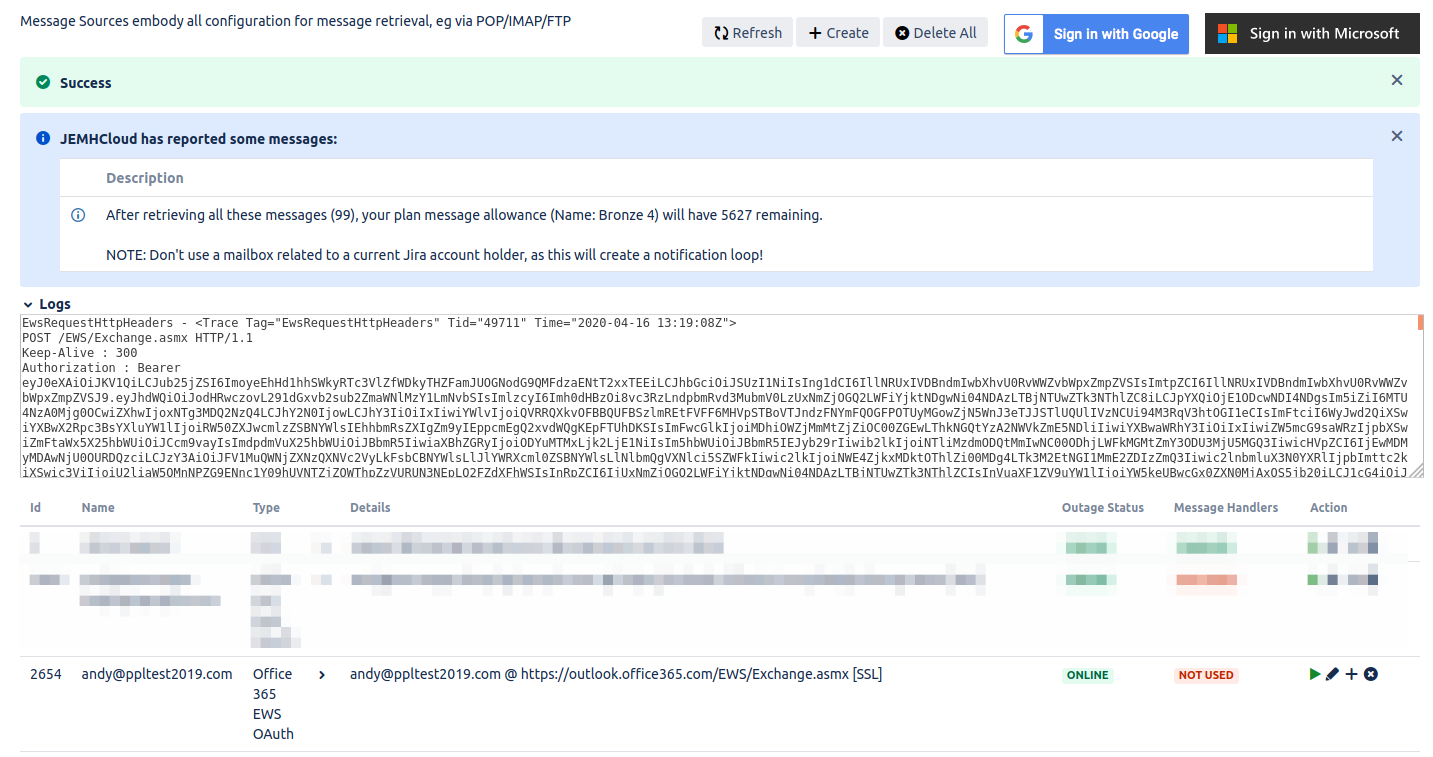...
As an Azure admin, ensure that users of JEMHC can request permissions via Microsoft Azure > Enterprise Applications > User settings. You will also need identify Users/Groups/Roles who will authorise admin consent requests from users configuring JEMHC.
...
Registration of JEMHC in your domain
Automatic registration through JEMHC authentication
Registration is automatic when a domain admin account is used in JEMHC incoming/outgoing mail connections through the “Sign in with Microsoft Button”:
...
On successful authentication, the JEMHC app registration will be made, here you can see 08b9fc2c-f6b8-4da0-8d4d-c065edfa949b is the ID of the application
...
It is now possible to delete the Message Source / Message Outbound in JEMHC using the Domain Admin account, and supply instead the mailbox user account, using the ‘play’ icon to validate the connection:
...
Manual registration before JEMHC authentication
We have had a length support call with Microsoft. No, you cannot register JEMHC in another other way than the above. JEMHC is not a user facing app, so is not in the ‘app gallery’ (costs with this are significant).
Is your Jira admin account single sign on with O365 as well? Having problems signing in to the mailbox?
It's solvable but not easy, see:
Granting consent
| Anchor | ||||
|---|---|---|---|---|
|
...
The following can be done via the Message Sources or Message Outbounds page under the Messaging tab, depending on whether you want to process or send emails respectively.
From the top right of the screen, select Sign in with Microsoft
At this point, you may be asked to grant consent to JEMHC acting on behalf of the signed in user. See the previous section on granting consent for more information.
After granting consent to the request, a screen confirming successful authorization is shown:
Returning to JEMHC, you should now see the new connection:
Clicking the green ping icon will then test the connection. A successful test will look similar to this:
The mail connection is now ready for use. These steps are identical for setting up both Message Sources and Message Outbounds.
Connection types
There are currently 2 types of connection JEMHC can make with Microsoft 365. Graph API connections make use of the Microsoft Graph API in order to access resources. These are recommended, and the default when the “Sign in with Microsoft” button is used inside the JEMHC UI.
Before addition of Graph API connections, EWS API connections were used. This connection type can still be created via the “create” button in the JEMHC UI, but will be removed at a later date.
Common Problems
Our support doesn’t extent to 3rd party mailhost configuration, we regret we are unable to help with detailed analysis, the following is mean to offer some insight and push you in the right direction for a resolution:
The provided grant has expired due to it being revoked, a fresh auth token is needed
You may be notified of a Message Source being offline:
SimpleHttpClientException: EWS. invalid_grant - AADSTS50173: The provided grant has expired due to it being revoked, a fresh auth token is needed. The user might have changed or reset their password. The grant was issued on '2022-07-19T15:24:40.8668421Z' and the TokensValidFrom date (before which tokens are not valid) for this user is '2023-03-13T20:21:32.0000000Z'…
This typically means that the Authentication of the inbound Source has not been used for period of time, and has been revoked by the mailhost. A re-authentication step is required in the Incoming Mail Source to get a auth token.
Device object was not found in the tenant
SimpleHttpClientException: EWS. invalid_grant - AADSTS700003: Device object was not found in the tenant ….
The offered solution seems to be:
The reason that the tokens are rejected is because the presence of the deviceId claim indicates a binding to that device and when this device is not found in the directory it indicates a revocation action where the device was deleted or disabled and tokens for that device will no longer be valid.
Work with the tenant administrator to get the device record restored https://learn.microsoft.com/en-us/azure/active-directory/devices/device-management-azure-portal#device-management-tasks%22
Acquire a new set of tokens, including a new refresh token.
HttpErrorException: The remote server returned an error: (401)
Typically this means that the mailserver is disallowing the use of the mailbox. As observed https://stackoverflow.com/questions/45725630/ews-connection-to-office365-fails-401-unauthorized it may be the case you need to request through your mailhost admin that the related mailbox to be specifically accessible for this app
Harmless problems
Some problems are transitory, there is nothing to typically do in these cases as connections are retried, examples of problems that can typically be ignored are:
SocketTimeoutException: Read timed out
Related articles
| Filter by label (Content by label) | ||||||||||||||||||
|---|---|---|---|---|---|---|---|---|---|---|---|---|---|---|---|---|---|---|
|
...



